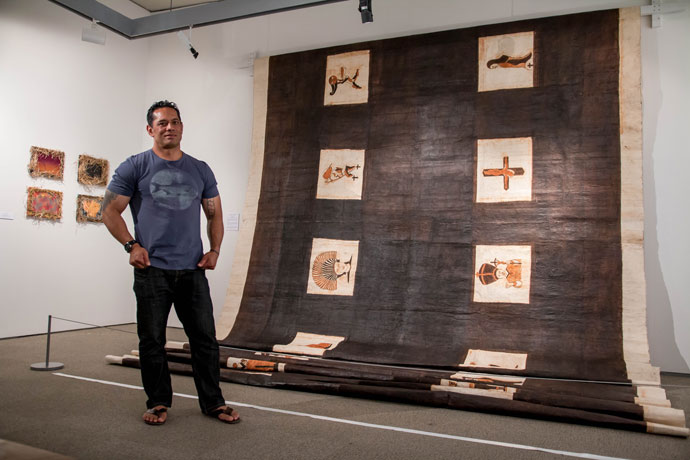From Tonga to New York!

Two Te Wānanga o Aotearoa arts graduates are about to pack their bags for a taste of the Big Apple.
Source: Te Wānanga o Aotearoa
Visesio Siasau and his wife Serene Tay, are off for a six-month residency at the International Studio and Curatorial Program in Brooklyn, New York after he was named Paramount Award Winner in the 24thWallace Art Awards earlier this month.
Visesio and Serene, who leave in March, are among the first graduates from He Waka Hiringa, the Master of Applied Indigenous Knowledge programme run by Te Wānanga o Aotearoa at Mangakōtukutuku in Hamilton.
Their collaborative piece – a 4.4m by 18m tapa cloth work titled Onotu’ofe’uli – Onotu’ofekula - was a labour of love more than two years in the making that included a stint at Visesio’s village in Tonga.
The enormous work, which had to be cut in half in Tonga so it could be brought on board a plane back to New Zealand, consists of 23 different stencil designs.
Visesio and Serene, who leave in March, are among the first graduates from He Waka Hiringa, the Master of Applied Indigenous Knowledge programme run by Te Wānanga o Aotearoa at Mangakōtukutuku in Hamilton.
Their collaborative piece – a 4.4m by 18m tapa cloth work titled Onotu’ofe’uli – Onotu’ofekula - was a labour of love more than two years in the making that included a stint at Visesio’s village in Tonga.
The enormous work, which had to be cut in half in Tonga so it could be brought on board a plane back to New Zealand, consists of 23 different stencil designs.

The Siasau fāmili with the award winning tapa Visesio & Serene collaborated on.
Each design offers a critical examination of the role of the Christian church in the Pacific Island nation and how traditional knowledge is perceived within that context.
“Ninety seven per cent of Tongans are Christians, we are absolutely dominated by Christianity and I believe that Tongan knowledge is underestimated by our people,” said Visesio.
A former electrician in the Tongan Navy, Visesio said he conducted the visual language and design for his artwork’s course requirements.
“I believe that art is an articulation, - especially to us indigenous people,” he said.
“The wood was the practical side of my philosophy. My wife was from the other side where she was preparing people spiritually and mentally to get the wood ready. “
The artwork is labour intensive and required thousands of layers of tapa sheets, which come from the mulberry bush that is beaten down into sheets.
The stencils are printed on sacks and the cloth is dyed using burnt candle nuts that are mixed and ground with black mangroves.
A sculptor, Visesio said the award, which includes a monthly stipend, will allow the couple “to go and focus only on art”.
The couple will be attending university lectures and engaging with other artists at museums and art galleries around what is arguably the world’s art capital
“New York is one of the main art centres in the world so to get to that level and take work from my Tongan inheritance creates a dialogue in the institution of art so people can open up and talk. Art is about breaking down boundaries.”
“I think it’s a good chance to push heritage work like ours into that dimension.”
The first Tongan to achieve the Wallace Art award, Visesio believes his time spent in New York should lead to more doors opening at art institutions around the world.
“I want to go to the unconverted who are in the hierarchy of every institution and try to present our knowledge to them and convince them to have a look that what we have is relevant.”
“From there we can work collaboratively and constructively as artists.”
Visesio says he has other projects lined up both in New Zealand and in Tonga when he returns from New York.
He believes his knowledge will enable him to benefit people within his community.
“I can contribute by teaching them the work from the pathways I have been on.”
“Tongans are too tempted by the western side and we tend to underestimate our art forms, like poetry and song.”
“I’d like to change that,” he said.
Image by Pataka
